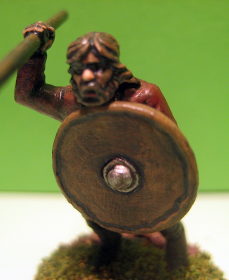You can, of course, buy your flags from a range of manufacturers these days and they range from reasonably priced but of questionable quality, to the beautifully produced but well beyond most people's wargames budget.
At the moment I have a mix of bought and home produced flags for my Wars of the Roses Lancastrians. I probably spend way too much time designing flags and, if I committed that time to painting, I'd probably double my output of completed figures.
To make my flags, I use Serif's Page Plus X2 to produce the basic background and any geometrical elements of the design. Any more complicated things like animals or flowers are obtained by endless trawling of the Internet. There are a couple of really good free heraldic design web sites available, but be warned, they don't have search facilities and you will have to click through page after page to find the design you need.
The one I used to use most was titled "Heraldry Clipart" and did exactly what it said on the tin. Most of the images were monochrome, which was brilliant, as you could add exactly the colours you needed for your flag. Sadly, "Heraldry Clipart" is no longer available and, at the time of this edit, I'm still searching for something to replace this brilliant resource.
Once I have produced the basic flag design, adding any charges to the geometric shapes produced in Page Plus, I then save it to a folder on my hard drive and fire up Adobe Photoshop Elements for the fun bit of the process.
My copy of Photoshop is version 8 and was downloaded for free. When you open up the flag design in Photoshop, you can start to bring it life by adding colour and brushing out any un-wanted lines from the Page Plus part of the process.
The three images above are a fairly simple example of the process in action. Sir Robert Knolly's flag was made by creating the field with a chevron in Page Plus. The red field was added in Photoshop and the flag was then re-opened in Page Plus for the roses to be added. Back then to Photoshop, where the overlapping part of the rose image was painted red to create the finished article.
Another example shows two stages in the process of making a flag for Sir Thomas Cruwys; the elements are put together in Page Plus, then everything is blended together in Photoshop, using the paintbucket and paintbrush tools to leave the flag ready for the final construction back in Page Plus.
The original design is only one half of the flag. This is copied and reversed to make the 'back' of the flag and a simple rectangle is added between the two to allow for wrapping around the flag pole.
Incidentally, I tend to save the completed flags as a PDF before printing as this appears to give a better quality finish.
One final example of the process in action, shows two stages of work in making a flag for Sir Humphrey Audley. At the Page Plus stage, the design is simply a set of overlapping lines, but once the image has been developed in Photoshop, this has become a knot with the lines weaving over and under ready to be added to the completed design as shown below:
As I said at the beginning, it takes up a lot of valuable painting time to create your own flags, so why bother?
Firstly, you can place your figures on the wargames table, stand back and say, with pride, "I made those flags!" That is much better than simply using bought ones that someone else has mass produced and lots of other people will have. It's unique!
Sir Nicholas Hervey, part of the Duke of Somerset's command. His arms are; Gules, on a bend argent, three trefoils vert.
Secondly, you can personalise them to suit your particular situation. If you need a smaller flag to fit a shorter pole, no problem. Or, if you're like me and you like to see massive flags flying above your troops, then you can print them larger than life and they look wonderful!
Sir John Langstrother, Prior of the Order of St. John of Jerusalem, part of Edward, Prince of Wales' command.
Sir John's position as Prior of the order created a really useful alternative to the normal coat of arms or livery badge. The flag shows the badge of the order rather than his personal coat of arms and I think is quite striking.
Just a final word on making your own flags, it does allow you to use your own imagination on what might have appeared on the battlefields of the Wars of the Roses. The flag below combines the coat of arms of the Marquis of Dorset with a livery badge of the Beaufort family...
And this is how my livery banner for Edward of Westminster was put together:
After all, who can state with any degree of certainty that such banners weren't carried by the standard bearers of the Wars of the Roses?
As an afterthought, I should point out that I, in no way, claim that any of my flags are historically accurate. I thought I'd better add this post script after entering into a 'handbags at dawn' episode, many years ago, with the proprietor of a well know historical book emporium, over an English Civil War flag I posted on the Internet. Hi Dave!!!


































